Study on Properties of Bone Glue/Polyurethane Composite Modified Asphalt and Its Mixture
Abstract
:1. Introduction
2. Materials and Test Methods
2.1. Materials
2.1.1. Neat Asphalt
2.1.2. Bone Glue
2.1.3. Polyurethane
2.1.4. Aggregates and Filler
2.2. Test Design
2.2.1. Preparation of the CMA
2.2.2. Mix Design of the CMA Mixture
2.3. Test Schemes
2.3.1. Physical Properties Test of Asphalt
2.3.2. Multiple Stress Creep Recovery Test (MSCR)
2.3.3. Bending Beam Rheometer Test (BBR)
2.3.4. High-Temperature Stability
2.3.5. Low-Temperature Stability
2.3.6. Water Stability
3. Results and Discussion
3.1. Performances of the CMA
3.1.1. Physical Properties
3.1.2. Creep Stiffness
3.1.3. Non-Recoverable Creep Compliance
3.2. Comprehensive Evaluation of Performance of CMA
3.3. Pavement Performance of the CMA Mixture
3.3.1. Determination of Optimum Asphalt Aggregate Radio
3.3.2. High-Temperature Stability
3.3.3. Low-Temperature Stability
3.3.4. Water Stability
4. Conclusions
- (1)
- The penetration, softening point, ductility, multiple stress creep test, and bending beam rheometer test was conducted. The influence of the content of bone glue and polyurethane on the CMA was studied. It concluded that bone glue/polyurethane CMA could effectively improve the high-temperature and low-temperature performance of asphalt.
- (2)
- The relationship between the performance indicators and modifiers’ content was revealed based on the test results. The fitting correlation coefficient of the model is greater than 0.85. The maximum relative error between the test results and the model prediction results is 10.67%. When the content of bone glue is 6.848%, and the polyurethane content is 2.759%, the performance of CMA is the best.
- (3)
- The pavement performance of neat asphalt mixture, SBS modified asphalt mixture, and bone cement/polyurethane CMA mixture were compared and analyzed. It is found that the low-temperature crack resistance and water stability of the CMA mixture are far superior to the other two asphalt mixtures. The CMA mixture’s dynamic stability is 85% of the SBS modified asphalt mixture but is 2.4 times that of the base asphalt mixture, which shows that the CMA mixture has also improved high-temperature stability.
- (4)
- In this paper, the properties of bone glue/polyurethane CMA and its mixture were studied. The optimal content of bone glue and polyurethane were determined. However, the modification mechanism of CMA and the durability of CMA mixture have not been studied yet. In order to better apply bone glue/polyurethane CMA in road engineering, the two aspects of research and the leaching tests will be carried out further.
Author Contributions
Funding
Institutional Review Board Statement
Informed Consent Statement
Data Availability Statement
Conflicts of Interest
References
- Lv, S.; Yuan, J.; Peng, X.; Borges Cabrera, M.; Liu, H.; Luo, X.; You, L. Standardization to evaluate the lasting capacity of rubberized asphalt mixtures with different testing approaches. Constr. Build. Mater. 2020, 121341. [Google Scholar] [CrossRef]
- Cheng, H.; Liu, J.; Sun, L.; Liu, L. Critical position of fatigue damage within asphalt pavement considering temperature and strain distribution. Int. J. Pavement Eng. 2020, 1–12. [Google Scholar] [CrossRef]
- Hussan, S.; Kamal, M.A.; Hafeez, I.; Ahmad, N.; Khanzada, S.; Ahmed, S. Modelling asphalt pavement analyzer rut depth using different statistical techniques. Road Mater. Pavement Des. 2020, 21, 117–142. [Google Scholar] [CrossRef]
- Li, Y.; Ding, H.; Nie, Y.; Hesp, S.A. Effective control of flexible asphalt pavement cracking through quality assurance testing of extracted and recovered binders. Constr. Build. Mater. 2020, 273, 121769. [Google Scholar] [CrossRef]
- Memon, M.G. Modified asphalt. U.S. Patent 6444731, 2002. [Google Scholar]
- Lv, S.; Yuan, J.; Peng, X.; Cabrera, M.B.; Gao, J. Performance and optimization of bio-oil/Buton rock asphalt composite modified asphalt. Constr. Build. Mater. 2020, 264, 120235. [Google Scholar] [CrossRef]
- Baumgardner, G.L.; Masson, J.F.; Hardee, J.R.; Menapace, A.M.; Williams, A.G. Polyphosphoric acid modified asphalt: Proposed mechanisms. J. Assoc. Asph. Paving Technol. 2005, 74, 283–305. [Google Scholar]
- An, M.; Hong, D.; Chang, D.; Wang, K.; Fan, H. Cadmium Distribution and Migration as Influenced by Polymer Modifiers in a Loam Soil. Rev. Chim. Buchar. Orig. Ed. 2020, 71, 633–645. [Google Scholar] [CrossRef]
- Klimek, K.; Ginalska, G. Proteins and Peptides as Important Modifiers of the Polymer Scaffolds for Tissue Engineering Applications—A Review. Polymers 2020, 12, 844. [Google Scholar] [CrossRef] [Green Version]
- Jha, A.; Dutta, B.; Bhowmick, A.K. Effect of fillers and plasticizers on the performance of novel heat and oil-resistant thermoplastic elastomers from nylon-6 and acrylate rubber blends. J. Appl. Polym. Sci. 2015, 74, 1490–1501. [Google Scholar] [CrossRef]
- Polacco, G.; Filippi, S.; Merusi, F.; Stastna, G. A review of the fundamentals of polymer-modified asphalts: Asphalt/polymer interactions and principles of compatibility. Adv. Colloid Interface Sci. 2015, 224, 72–112. [Google Scholar] [CrossRef] [PubMed]
- Jiang, J.; Ni, F.; Zheng, J.; Han, Y.; Zhao, X. Improving the high-temperature performance of cold recycled mixtures by polymer-modified asphalt emulsion. Int. J. Pavement Eng. 2020, 21, 41–48. [Google Scholar] [CrossRef]
- Khattak, M.; Baladi, G. Engineering properties of polymer-modified asphalt mixtures. Transp. Res. Rec. 1998, 1638, 12–22. [Google Scholar] [CrossRef]
- Berezin, A.S.; Artem’Ev, A.V.; Komarov, V.Y.; Baranov, A.Y. A copper(I) bromide organic–inorganic zwitterionic coordination compound with a new type of core: Structure, luminescence properties, and DFT calculations. New J. Chem. 2020, 44, 9858–9862. [Google Scholar] [CrossRef]
- Li, C. Preparation of polyurethane modified asphalt and research on road performance evaluation of mixture. J. Wuhan Univ. Technol. (Transp. Sci. Eng.) 2017, 41, 958–963. [Google Scholar] [CrossRef]
- Bazmara, B.; Tahersima, M.; Behravan, A. Influence of thermoplastic polyurethane and synthesized polyurethane additive in performance of asphalt pavements. Constr. Build. Mater. 2018, 166, 1–11. [Google Scholar] [CrossRef]
- Khairuddin, F.H.; Alamawi, M.Y.; Yusoff, N.I.M.; Badri, K.H.; Ceylan, H.; Tawil, S.N.M. Physicochemical and thermal analyses of polyurethane modified bitumen incorporated with Cecabase and Rediset: Optimization using response surface methodology. Fuel 2019, 254, 115662. [Google Scholar] [CrossRef]
- Yao, Z.P.; Li, M.; Liu, W.; Chen, Z.B.; Zhang, R.H. A Study of Polyurethane Rubber Composite Modified Asphalt Mixture. Adv. Mater. Res. 2014, 941–944, 324–328. [Google Scholar] [CrossRef]
- Zhang, M.; Dong, R. Reaction mechanism and rheological properties of waste cooking oil pre-desulfurized crumb tire rubber/SBS composite modified asphalt. Constr. Build. Mater. 2021, 274, 122083. [Google Scholar]
- Wei, Y.; Guo, N.; Wang, L.; Jiao, B.; Li, W. Rheological properties and microscopic mechanism of rock asphalt composite modified asphalts. Constr. Build. Mater. 2021, 281, 122543. [Google Scholar]
- Jin, X.; Guo, N.; Yan, S.; Liu, T.; You, Z. Preparetion and performance evaluation on polyurethane composite modified asphalt. China J. Highw. Transp. 2020, 12, 1–24. [Google Scholar]
- Bu, X.; Cheng, F. Research on performance of polyurethane-epoxy resin compound modified asphalt and its mixture. Highway 2016, 61, 171–174. [Google Scholar]
- Yu, R. Prepartion and Properties of Asphalt Modified with Graphene Oxide/Polyurethane Composite. Master’s Thesis, Xi’an University of Technology, Xi’an, China, 2016. [Google Scholar]
- Zhang, H.; Gong, M.; Gao, D.; Yang, T.; Huang, Y. Comparative analysis of mechanical behavior of composite modified asphalt mixture based on PG technology. Constr. Build. Mater. 2020, 259, 119771. [Google Scholar] [CrossRef]
- Feng, Z.; Pan, L.; Kai, L.; Xingyue, S.; Lu, L. Study on the Pavement Performance of DOA/SBS Compound Modified Asphalt and Its Mixture. Pet. Asph. 2020. [Google Scholar]
- Goryachko, A.I.; Ivanin, S.N.; Buz’Ko, V.Y. Electromagnetic Properties of Composite Materials Based on Nd-Compound Modified Fe-Si-Al Alloy. In IOP Conference Series: Materials ence and Engineering; IOP Publishing: Bristol, UK, 2020; Volume 969, pp. 012017–012019. [Google Scholar]
- Zhang, Z.; Li, J.; Wang, Z.; Long, S.; Liu, G. Preparation and performance characterization of a novel high-performance epoxy resin modified reactive liquid asphalt. Constr. Build. Mater. 2020, 263, 120113. [Google Scholar] [CrossRef]
- Le, J.L.; Marasteanu, M.O.; Turos, M. Mechanical and compaction properties of graphite nanoplatelet-modified asphalt binders and mixtures. Road Mater. Pavement Des. 2020, 21, 1799–1814. [Google Scholar] [CrossRef]
- Rizvi, H.R.; Khattak, M.J.; Gallo, A.A. Rheological and mechanistic characteristics of Bone Glue modified asphalt binders. Constr. Build. Mater. 2015, 88, 64–73. [Google Scholar] [CrossRef]
- Rizvi, H.R.; Khattak, M.J.; Gallo, A.A. Bone Glue Modified Asphalt: A Step towards Energy Conservation and Environment Friendly Modified Asphalts. Int. Sch. Res. Not. 2014, 2014, 807043. [Google Scholar] [CrossRef]
- Ye, Q.; Wang, S.; Li, H.; Peng, K. Study on the rheological properties of new bone glue modified asphalt. J. Changsha Univ. Sci. Technol. (Nat. Sci.) 2020, 17, 33–38. [Google Scholar]
- Rizvi, H.R.; Mehta, Y.; Weis, D.; Purdy, C. Bone Glue Modified Fuel Resistant Asphalt Binder. J. Test. Eval. 2019, 47, 1793–1808. [Google Scholar] [CrossRef]
- Ali, A.; Ahmad, N.; Adeel, M.; Zaidi, S.B.A.; Jameel, M.S.; Qureshi, F.A.; Haroon, W.; Asif, S.A. Performance Evaluation of Bone Glue-Modified Asphalt. Adv. Mater. Sci. Eng. 2019, 2019, 13. [Google Scholar] [CrossRef] [Green Version]
- Bu, H.; Su, X.; Guo, M. Discussion on some modification methods of bone glue. China Adhes. 2015, 24, 591–594. [Google Scholar]
- Guo, M.; Su, X.; Zhou, L. Preparation and bonding technology of aluminum sulfate modified bone glue. China Adhes. 2015, 24, 29–32. [Google Scholar]
- Guo, M.; Su, X.; Zhou, L. Study on the synthesis mechanism and water resistance of the Al3+ modified bone glue. J. Funct. Mater. 2015, 46, 12039–12043. [Google Scholar]
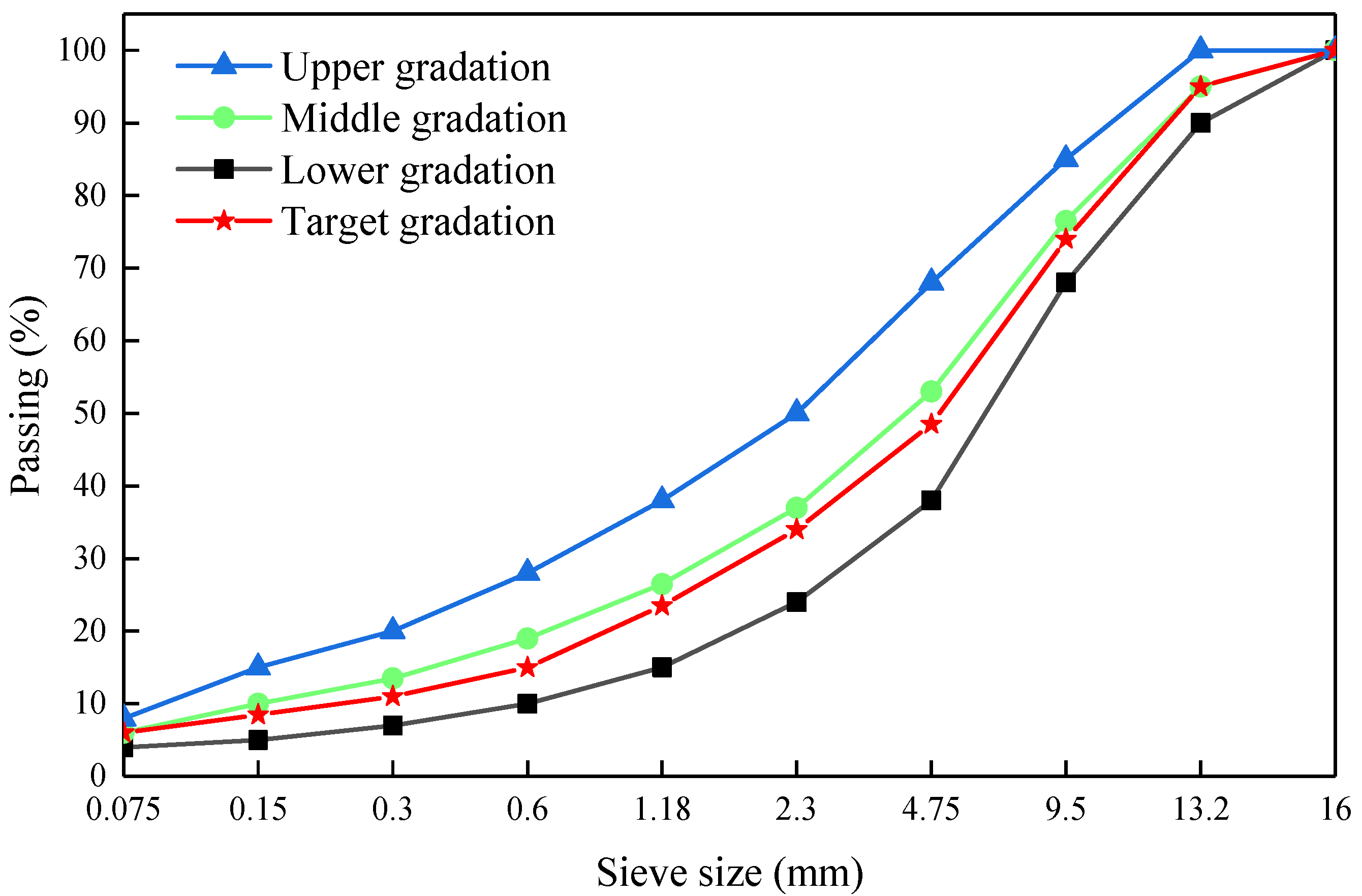
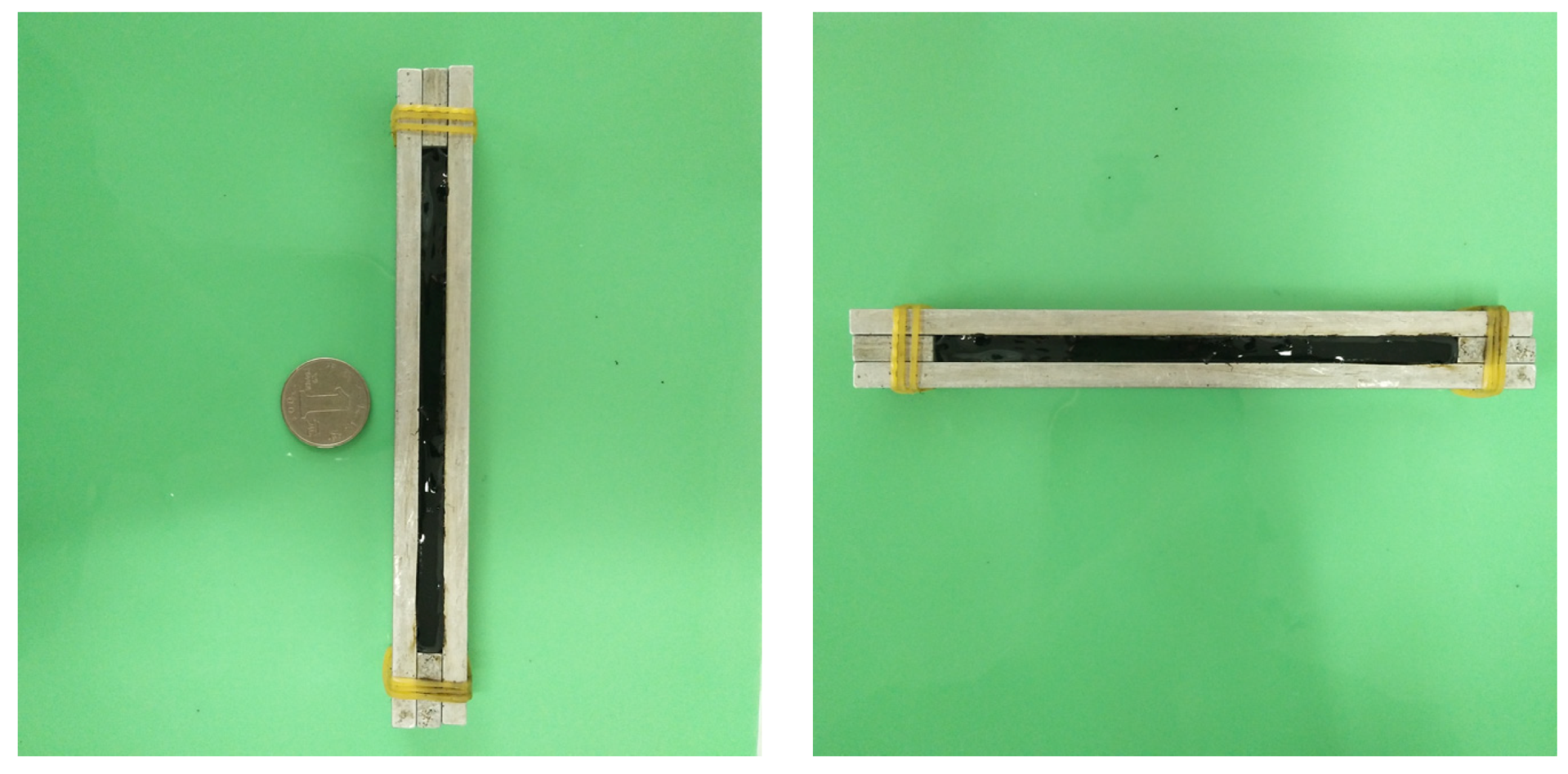
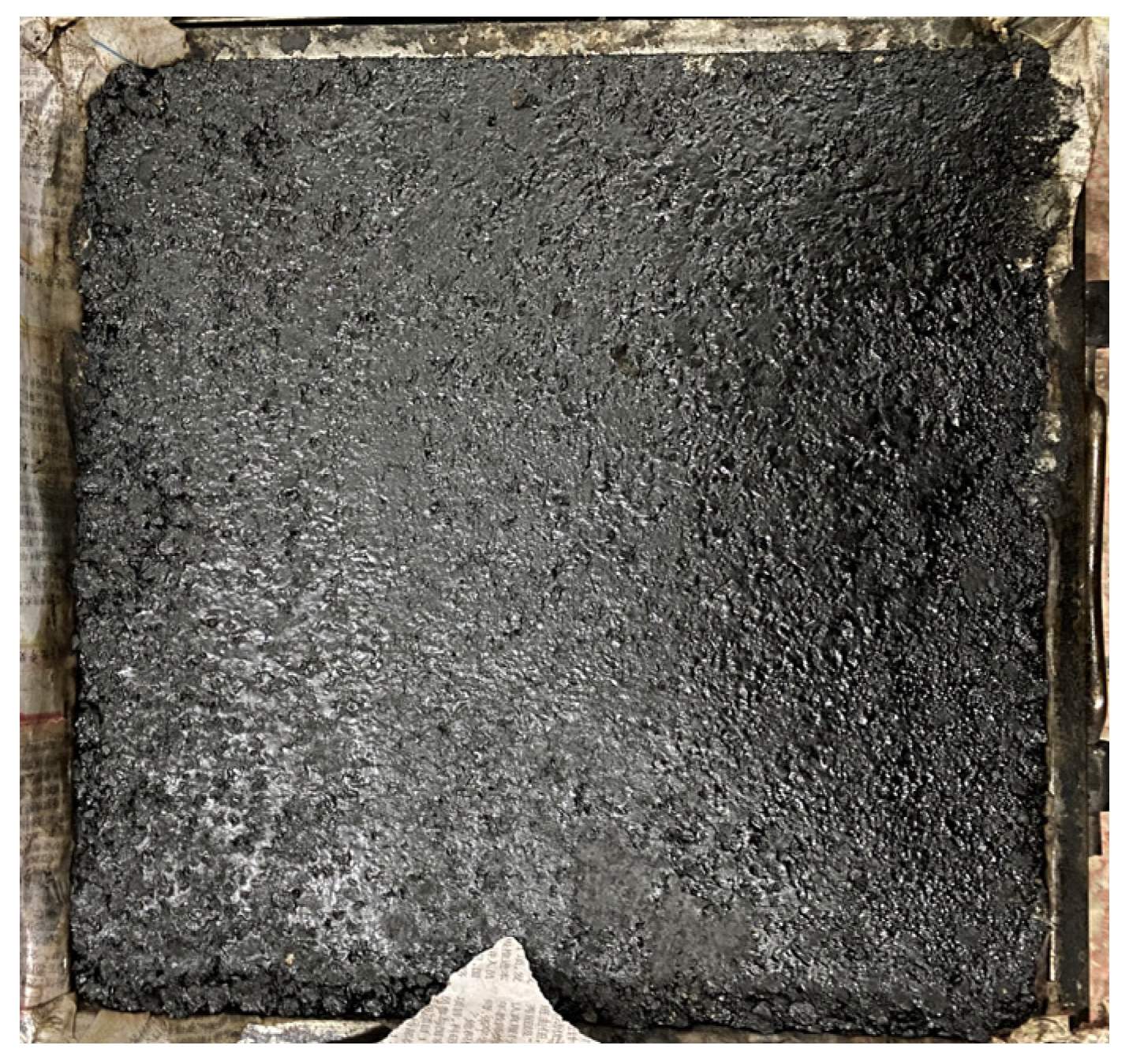

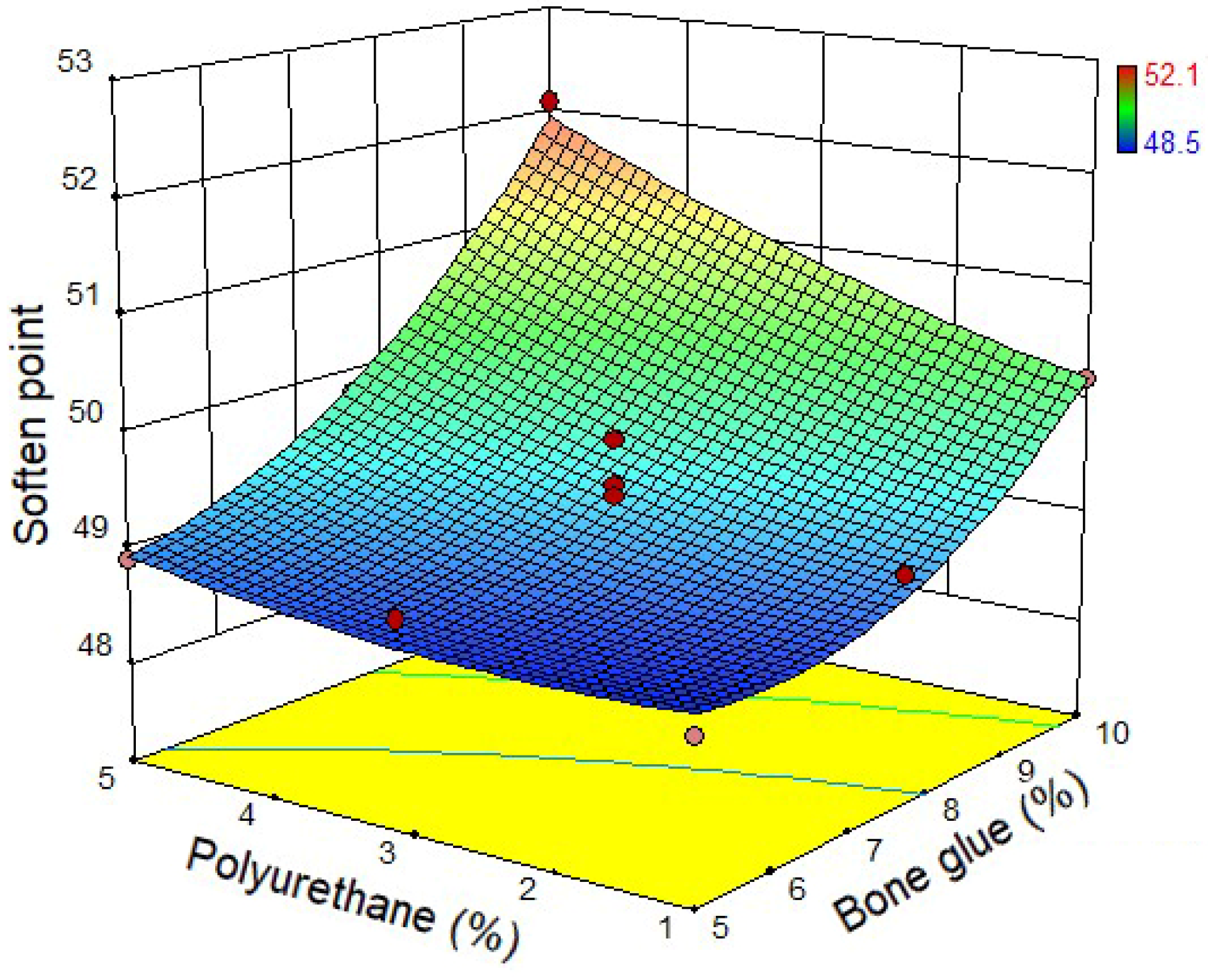
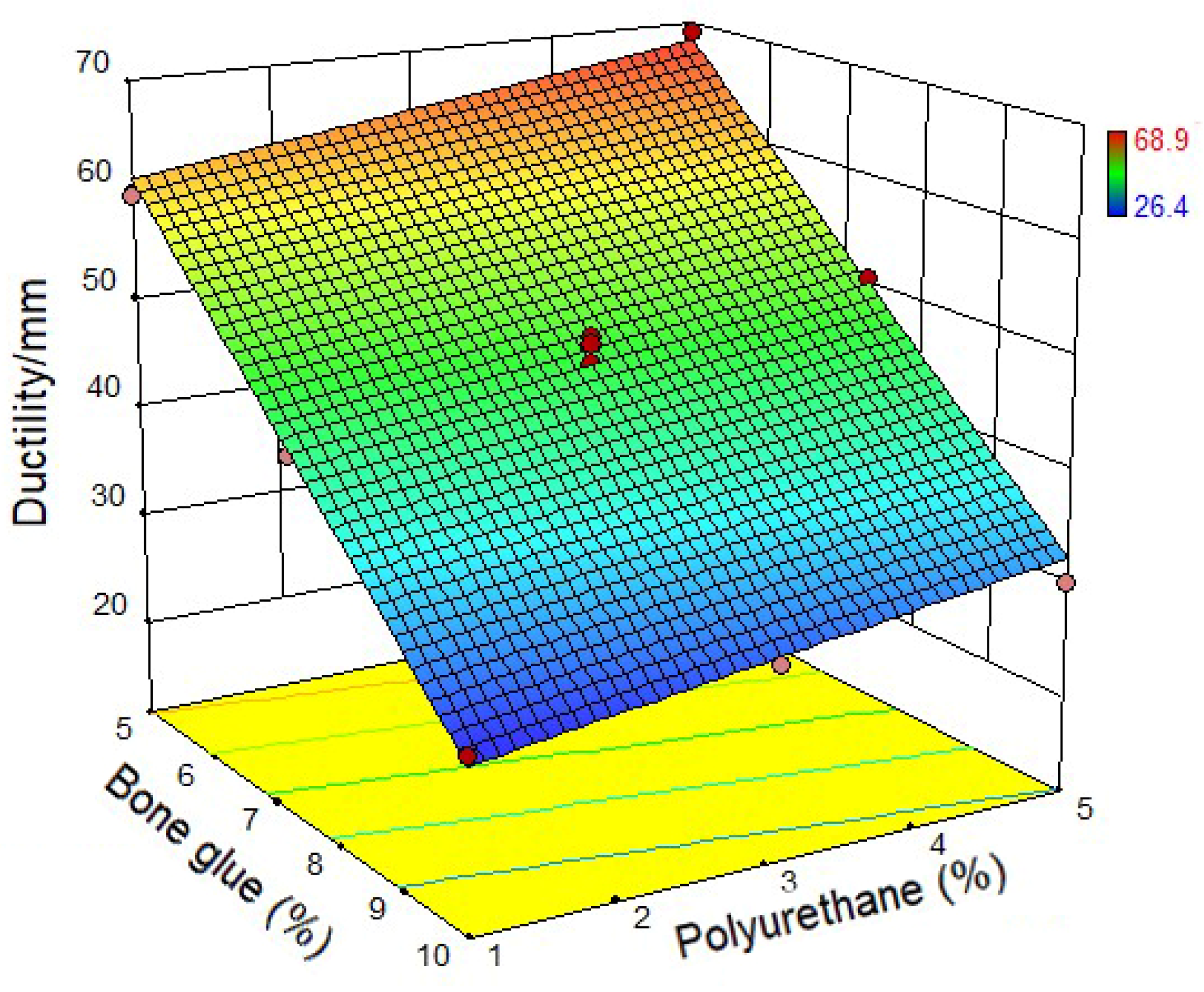
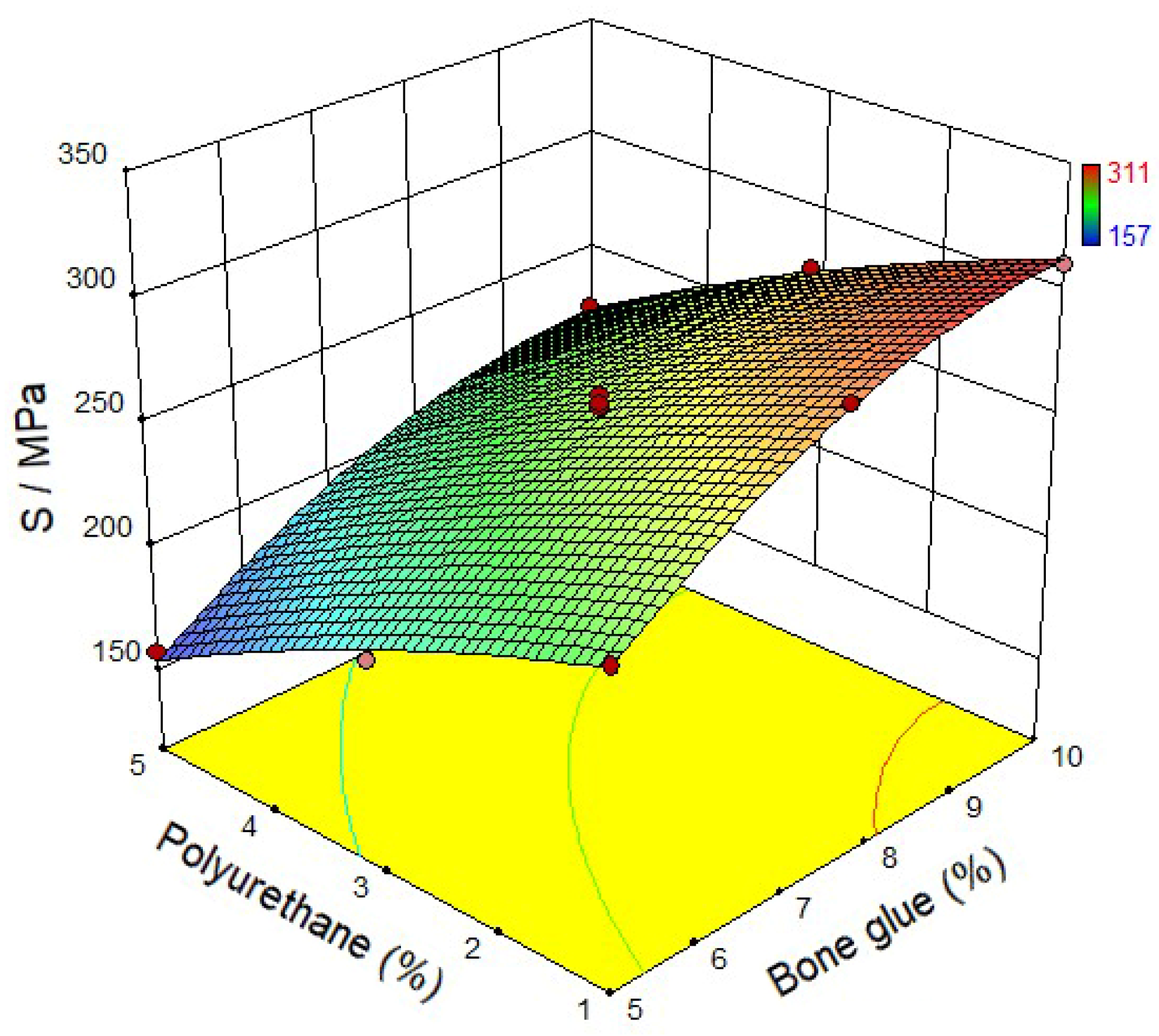
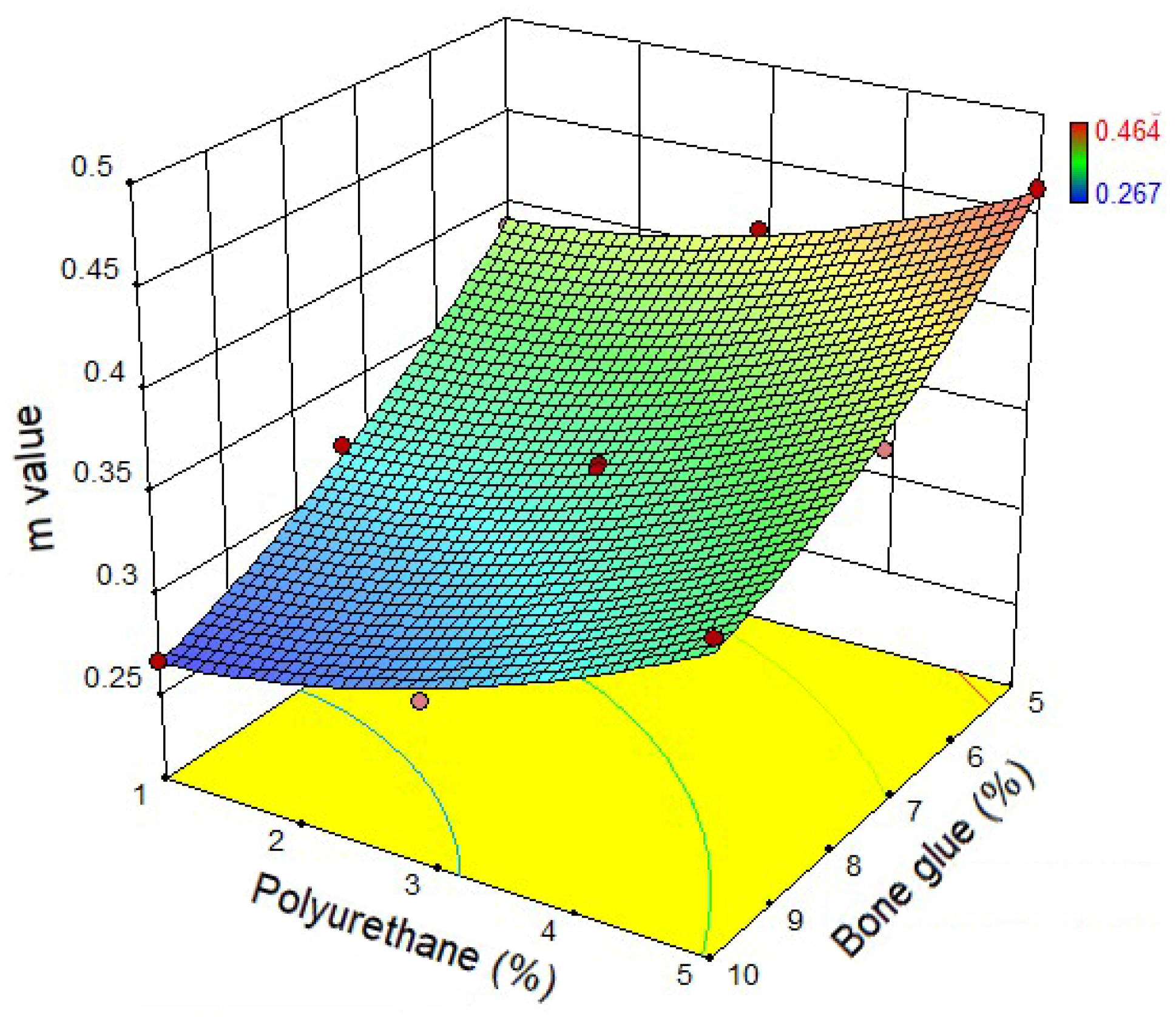
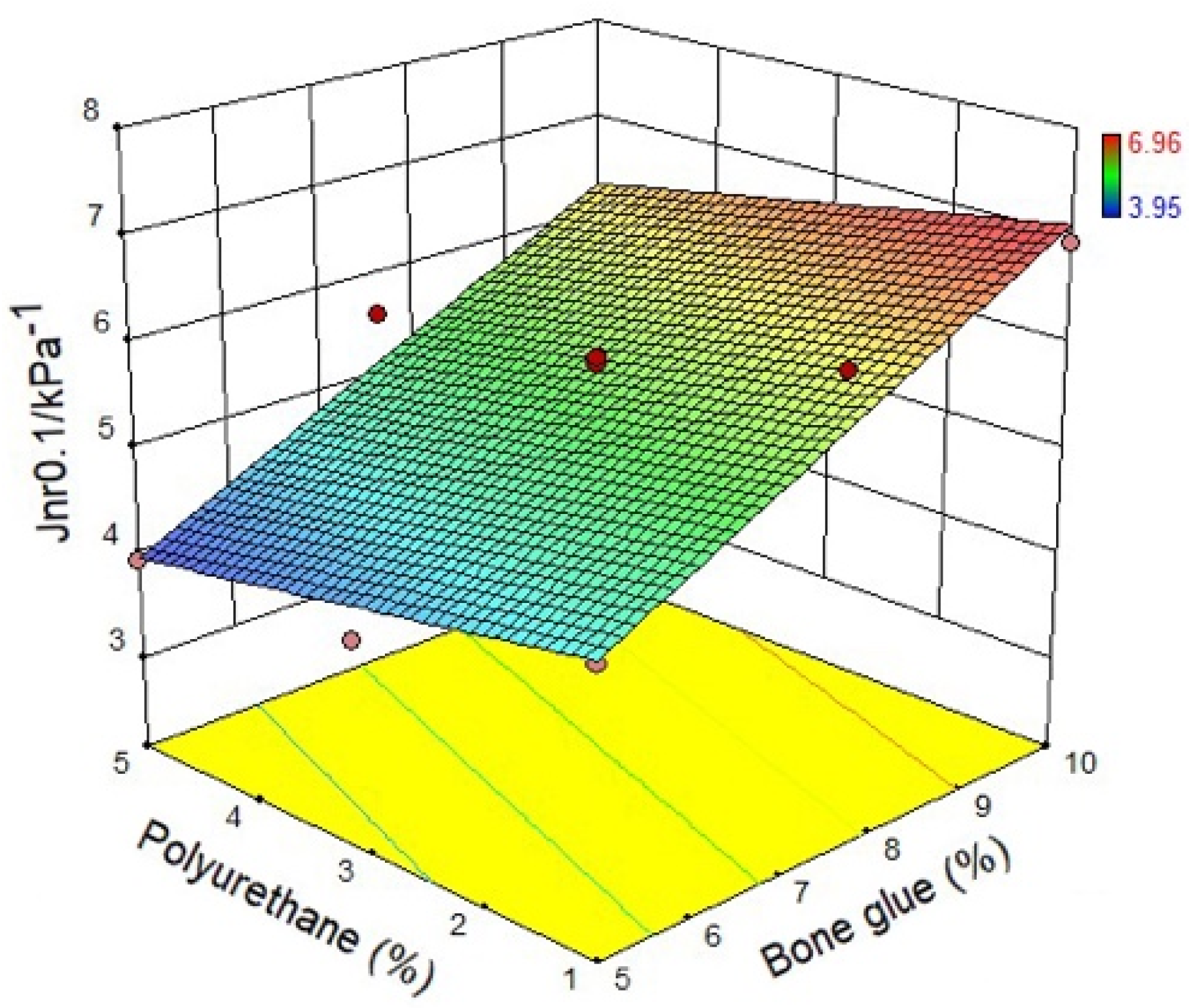
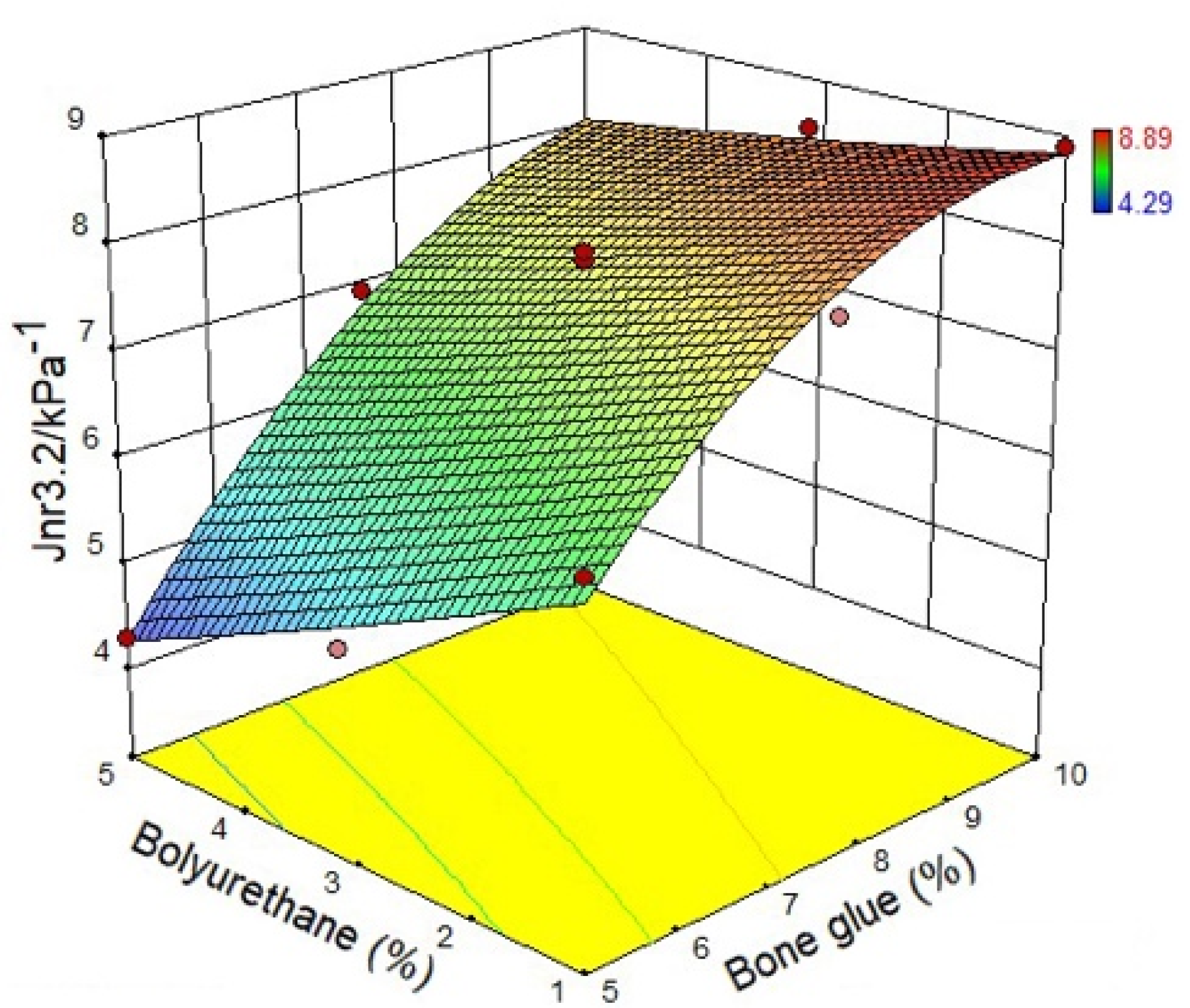
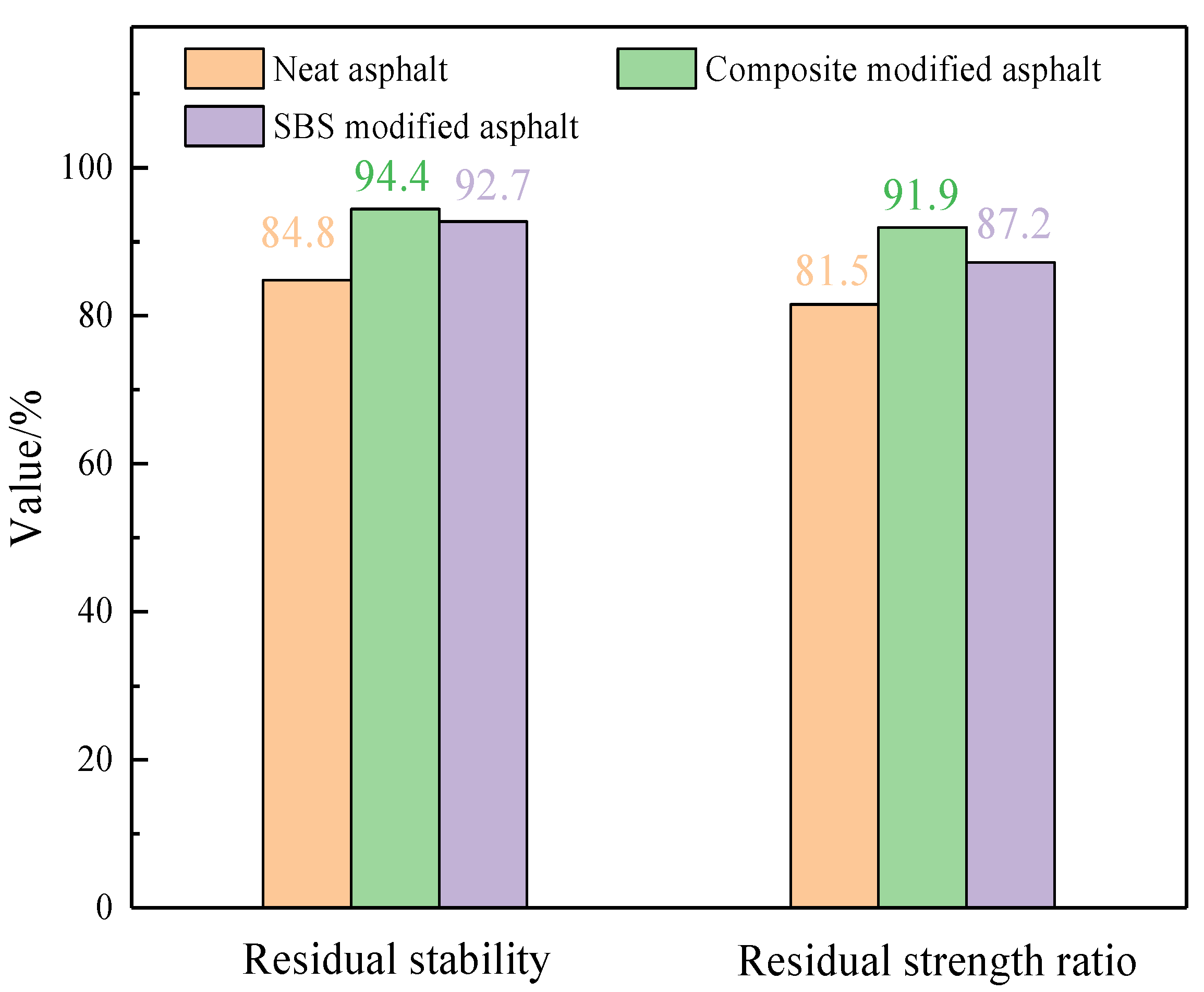
| Technical Index | Test Results | Technical Standard |
|---|---|---|
| Penetration at 25 °C/0.1 mm | 67.8 | 60–80 |
| Softening point (°C) | 46.6 | ≥46 |
| Ductility at 10 °C/cm | 42 | ≥20 |
| Ductility at 15 °C/cm | 110 | ≥100 |
| Density at 15 °C/g/cm3 | 1.029 | - |
| Technical Index | Test Results |
|---|---|
| Density (g/cm3) | 1.11 |
| Tear strength (N/mm2) | 68 |
| Hardness/Shore A | 88 |
| Tensile strength (N/mm2) | 46 |
| Size (mm) | Apparent Relative Density (g/cm3) | Bulk Volume Relative Density (g/cm3) | Water Absorption (%) |
|---|---|---|---|
| 16–13.2 | 2.562 | 2.581 | 1.24 |
| 13.2–9.5 | 2.654 | 2.572 | 1.53 |
| 9.5–4.75 | 2.648 | 2.585 | 1.35 |
| 4.75–2.36 | 2.640 | - | - |
| 2.36–1.18 | 2.635 | ||
| 1.18–0.6 | 2.602 | ||
| 0.6–0.3 | 2.588 | ||
| 0.3–0.15 | 2.576 | ||
| 0.15–0.075 | 2.609 |
| Number | Bone Glue Content (%) | Polyurethane Content (%) |
|---|---|---|
| 1 | 7.5 | 3 |
| 2 | 7.5 | 3 |
| 3 | 7.5 | 1 |
| 4 | 5 | 3 |
| 5 | 7.5 | 3 |
| 6 | 7.5 | 3 |
| 7 | 5 | 5 |
| 8 | 5 | 1 |
| 9 | 10 | 1 |
| 10 | 10 | 5 |
| 11 | 7.5 | 3 |
| 12 | 7.5 | 5 |
| 13 | 10 | 3 |
| Index | Pen | Sp | Du | S | m | Jnr0.1 | Jnr3.2 |
|---|---|---|---|---|---|---|---|
| Model | Linear | Quadratic | Linear | Quadratic | Quadratic | Linear | Quadratic |
| R2 | 0.8595 | 0.9222 | 0.9870 | 0.9934 | 0.9929 | 0.8861 | 0.9610 |
| Adjustment. R2 | 0.9314 | 0.8666 | 0.9844 | 0.9887 | 0.9878 | 0.8634 | 0.9331 |
| Coefficient of Variation.% | 5.42 | 0.74 | 3.45 | 1.81 | 1.62 | 6.22 | 4.67 |
| Model F-value | 30.59 | 16.59 | 378.49 | 210.12 | 194.81 | 38.92 | 34.47 |
| Lack-of-Fit p value | 0.8872 | 0.8056 | 0.5425 | 0.3468 | 0.0952 | 0.5852 | 0.7429 |
| Model p-value | <0.0001 | 0.0009 | <0.0001 | <0.0001 | <0.0001 | <0.0001 | <0.0001 |
| Press | 117.28 | 2.92 | 47.95 | 771.37 | 0.002 | 1.83 | 2.81 |
| Standard Deviation | 2.83 | 0.37 | 1.62 | 4.43 | 0.005 | 0.35 | 0.34 |
| No. | Pen | Sp | Du | S | ||||||||
|---|---|---|---|---|---|---|---|---|---|---|---|---|
| Test | Predicted | Relative Error (%) | Test | Predicted | Relative Error (%) | Test | Predicted | Relative Error (%) | Test | Predicted | Relative Error (%) | |
| 1 | 58 | 52.15 | 10.09 | 48.7 | 49.24 | −1.11 | 46.9 | 46.89 | 0.02 | 258 | 255.69 | 0.90 |
| 2 | 49 | 52.15 | −6.43 | 49.8 | 49.24 | 1.12 | 45.3 | 46.89 | −3.51 | 261 | 255.69 | 2.03 |
| 3 | 46 | 46.65 | −1.41 | 49.1 | 48.90 | 0.41 | 43.1 | 43.43 | −0.77 | 295 | 293.61 | 0.47 |
| 4 | 58 | 59.32 | −2.28 | 48.9 | 48.66 | 0.49 | 63.5 | 64.74 | −1.95 | 198 | 202.61 | −2.33 |
| 5 | 51 | 52.15 | −2.25 | 48.9 | 49.24 | −0.70 | 49.3 | 46.89 | 4.89 | 256 | 255.69 | 0.12 |
| 6 | 54 | 52.15 | 3.43 | 49.4 | 49.24 | 0.32 | 48.6 | 46.89 | 3.52 | 257 | 255.69 | 0.51 |
| 7 | 63 | 64.82 | −2.89 | 48.9 | 48.94 | −0.08 | 68.9 | 68.21 | 1.00 | 157 | 153.11 | 2.48 |
| 8 | 53 | 53.82 | −1.55 | 48.5 | 48.69 | −0.39 | 59.6 | 61.28 | −2.82 | 241 | 240.28 | 0.30 |
| 9 | 38 | 39.49 | −3.92 | 50.2 | 50.21 | −0.02 | 26.4 | 25.58 | 3.11 | 311 | 313.11 | −0.68 |
| 10 | 48 | 50.49 | −5.19 | 52.1 | 51.96 | 0.27 | 30.2 | 32.51 | −7.65 | 226 | 224.95 | 0.47 |
| 11 | 56 | 52.15 | 6.88 | 49.3 | 49.24 | 0.12 | 48.7 | 46.89 | 3.72 | 250 | 255.69 | −2.28 |
| 12 | 59 | 57.65 | 2.29 | 49.8 | 49.90 | −0.20 | 50.8 | 50.36 | 0.87 | 201 | 205.94 | −2.46 |
| 13 | 45 | 44.99 | 0.02 | 50.8 | 50.93 | −0.26 | 28.3 | 29.04 | −2.61 | 276 | 274.94 | 0.38 |
| No. | m | Jnr0.1 | Jnr3.2 | ||||||
|---|---|---|---|---|---|---|---|---|---|
| Test | Predicted | Relative Error (%) | Test | Predicted | Relative Error (%) | Test | Predicted | Relative Error (%) | |
| 1 | 0.342 | 0.34 | 0.47 | 5.02 | 5.56 | −10.67 | 7.34 | 7.51 | −2.27 |
| 2 | 0.335 | 0.34 | −1.61 | 5.36 | 5.56 | −3.65 | 7.96 | 7.51 | 5.70 |
| 3 | 0.321 | 0.32 | 1.28 | 6.48 | 5.95 | 8.12 | 8.02 | 8.26 | −2.98 |
| 4 | 0.416 | 0.41 | 0.75 | 4.05 | 4.38 | −8.08 | 5.07 | 5.28 | −4.18 |
| 5 | 0.341 | 0.34 | 0.18 | 5.45 | 5.56 | −1.93 | 7.02 | 7.51 | −6.93 |
| 6 | 0.342 | 0.34 | 0.47 | 5.84 | 5.56 | 4.87 | 7.87 | 7.51 | 4.62 |
| 7 | 0.464 | 0.46 | 0.27 | 3.95 | 3.98 | −0.73 | 4.29 | 4.28 | 0.31 |
| 8 | 0.389 | 0.39 | −1.13 | 4.74 | 4.78 | −0.75 | 6.56 | 6.36 | 3.03 |
| 9 | 0.267 | 0.27 | 0.10 | 6.96 | 7.13 | −2.47 | 8.89 | 8.85 | 0.45 |
| 10 | 0.358 | 0.35 | 1.66 | 6.21 | 6.34 | −2.02 | 7.93 | 8.07 | −1.83 |
| 11 | 0.345 | 0.34 | 1.34 | 5.89 | 5.56 | 5.68 | 7.45 | 7.51 | −0.76 |
| 12 | 0.387 | 0.39 | −1.87 | 5.63 | 5.16 | 8.40 | 6.96 | 6.83 | 1.89 |
| 13 | 0.288 | 0.29 | −2.16 | 6.64 | 6.73 | −1.41 | 8.53 | 8.43 | 1.23 |
| Index | Pen | Sp | Du | S | m | Jnr0.1 | Jnr3.2 |
|---|---|---|---|---|---|---|---|
| Unit | 25 °C/0.1 mm | °C | 5 °C/mm | MPa | - | kPa−1 | kPa−1 |
| Test results | 54.2 | 49.1 | 52.3 | 236.84 | 0.358 | 5.186 | 7.039 |
| Predicted results | 53.4 | 48.9 | 51.1 | 250.29 | 0.352 | 5.296 | 7.149 |
| Relative error (%) | 1.48 | 0.41 | 2.29 | −5.68 | 1.68 | −2.12 | −1.56 |
| Asphalt Aggregate Radio (%) | 4.0 | 4.5 | 5.0 | 5.5 | 6.0 |
|---|---|---|---|---|---|
| Bulk density (g·cm−3) | 2.418 | 2.440 | 2.472 | 2.488 | 2.475 |
| Stability (kN) | 17.31 | 18.42 | 18.94 | 18.60 | 18.16 |
| Air void (%) | 6.2 | 4.9 | 3.7 | 3 | 2.2 |
| Flow value (mm) | 2.01 | 2.75 | 3.10 | 3.52 | 4.21 |
| Void ratio of mineral aggregate (%) | 14.1 | 13.2 | 13.4 | 13.7 | 14.5 |
| Saturation (%) | 55.0 | 60.2 | 66.8 | 71.9 | 81.4 |
| Type of Mixture | Rutting Depth at 60 min/mm | Dynamic Stability/Times·(mm−1) |
|---|---|---|
| Neat asphalt | 4.308 | 1624 |
| Bone glue/polyurethane CMA | 3.041 | 3978 |
| SBS modified asphalt | 2.941 | 4630 |
| Type of Mixture | Maximum Load (N) | Maximum Bending Tensile Strain (×10−3) | Flexural Tensile Strength (MPa) | Mid Span Deflection at Failure (mm) | Bending Stiffness Modulus (MPa) |
|---|---|---|---|---|---|
| Neat asphalt | 1002.48 | 2.15 | 7.52 | 0.4186 | 2489 |
| Bone glue/polyurethane CMA | 1391.69 | 4.18 | 10.98 | 0.8168 | 3648 |
| SBS modified asphalt | 1179.65 | 3.25 | 8.81 | 0.6248 | 2948 |
Publisher’s Note: MDPI stays neutral with regard to jurisdictional claims in published maps and institutional affiliations. |
© 2021 by the authors. Licensee MDPI, Basel, Switzerland. This article is an open access article distributed under the terms and conditions of the Creative Commons Attribution (CC BY) license (https://creativecommons.org/licenses/by/4.0/).
Share and Cite
Yan, W.; Ou, Y.; Xie, J.; Huang, T.; Peng, X. Study on Properties of Bone Glue/Polyurethane Composite Modified Asphalt and Its Mixture. Materials 2021, 14, 3769. https://doi.org/10.3390/ma14143769
Yan W, Ou Y, Xie J, Huang T, Peng X. Study on Properties of Bone Glue/Polyurethane Composite Modified Asphalt and Its Mixture. Materials. 2021; 14(14):3769. https://doi.org/10.3390/ma14143769
Chicago/Turabian StyleYan, Wei, Yangjia Ou, Jing Xie, Tuo Huang, and Xinghai Peng. 2021. "Study on Properties of Bone Glue/Polyurethane Composite Modified Asphalt and Its Mixture" Materials 14, no. 14: 3769. https://doi.org/10.3390/ma14143769
APA StyleYan, W., Ou, Y., Xie, J., Huang, T., & Peng, X. (2021). Study on Properties of Bone Glue/Polyurethane Composite Modified Asphalt and Its Mixture. Materials, 14(14), 3769. https://doi.org/10.3390/ma14143769






